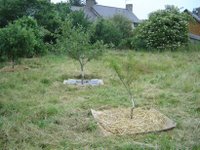
Sorting out the existing fruit trees was today’s task. We hope to design an orchard / forest garden in our second field but, for now, I wanted to improve the health of the existing fruit trees: a small apple tree at the back of our vegetable garden and two more apples, a small peach tree and a neglected plum tree in the field.
According to Patrick Whitefield in The Earth Care Manual, “Grass is the worst enemy of young trees. Older trees can co-exist with it quite happily, but young ones can make little or no growth for years if planted directly into a grass sward”(p.327). So, the first job was to cut the grass around the trees and mulch with a layer of cardboard topped off with six inches of straw and, for one apple (to compare performance) layers of newspaper. Although it would’ve been better if they’d had them over the winter, the trees will still get some benefit from the sticky bandages I tied onto their trucks, which will trap ants and earwigs over the summer.
Bob Flowerdew , in The No Work Garden, explains that, for the tree, the seed is important, both for reproduction and for the energy expended creating them (p.112). He suggests that, if you remove nearly half of the fruit before it fully develops, you’ll still get a similar weight of crop, meaning that the fruit you eventually pick will be twice the size. The tree puts less effort into the (mainly water and sugar) flesh that we enjoy eating than the seeds, so is less exhausted on a good year and more likely to crop well again the following year. It’s easy picking off marked, nibbled or diseased fruit but a bit more nerve-racking to thin those in good condition.
The plum tree was in a state of neglect and two branches hadn’t been properly cut back to the trunk when pruned in the past. This has allowed them to die back and rot has entered the trunk. Desperate action was called for, and I’ll tell you what I did next post but, for the moment, the World Cup calls!
